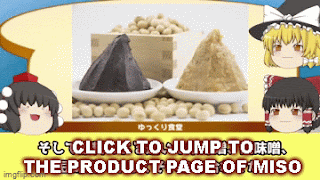I was told I was a doctor's killer... I kept drinking miso soup every day... I've been drinking miso soup every day...
Reimu: "Zulu zulu ah, my body is warming up"
Marisa: "What the hell is that? What are you eating, Reimu?"
Kime-maru: "I'm eating something that looks kind of warm..."
Reimu: "Ah, miso soup, miso soup... I drink it every day, but the miso soup I drink in winter is the best..."
Marisa: "Miso soup, I want some too!"
Reimu: "Okay, okay♪ Today I put in plenty of wakame seaweed and tofu, so it's a very satisfying miso soup."
Kime-maru: "It looks really delicious... ♪ By the way, Reimu and Marisa, do you know that miso is incredibly good for humans?"
Reimu: "Outrageously?"
Marisa: "Well, I don't have a bad image of it, but I don't really have an image of it being an amazingly great thing either."
Reimu: "Sure, sure, sure! Tell me more about it."
Kime-maru: "Yes, I see... this time I will slowly explain about miso, Japan's proud health food, the power of miso, which has even been called the "doctor-killer", and the little-known points to note about miso..."
Kime-maru: "Do you drink miso soup every day? I'm introducing recommended miso, so if you're interested in it after listening to this talk, please check it out."
Well then, today too, the diner opens slowly.
What is miso?
Kime-maru: "First, let me briefly explain about miso. Miso is one of fermented foods made by fermenting soybeans, rice, wheat and other grains, combined with salt and koji. It is usually distributed in paste form. It is one of Japan's traditional foods and is often used in Japan, but now it has become one of the most famous seasonings overseas as well."
Reimu: "I thought it was something unique to Japan, but I'm very happy that it's also popular overseas. I'm so big that I can enter the world too..."
Kime-maru: "Reimu-san has become big in a sense..."
Reimu: 'I'm hiding the fact that I'm gaining weight at New Year's from you, the viewers, so don't tell me...'
Kime-maru: "I'm sure you know that there are several types of miso, but the differences depend on the maturation period and ingredients."
Marisa: "What kind of things are there, for example?"
Kime-maru: "Shiro-miso, which is used mostly in Kinki, Okayama, Hiroshima and Kagawa prefectures, has a whitish colour due to its short maturation period. Its salt content is lower than others. As those who have eaten it know, it is a miso with a slightly sweet taste."
Reimu: "Oh sure it's a bit sweet! I remember the first time I tried a white miso paste, it was a bit sweet and creamy, and I thought it was really miso! I remember feeling like it was really miso!"
Kime-maru: "And the opposite of white miso is aka miso, and the difference in colour lies in the maturation period. While the white miso mentioned earlier was matured for a short period of time, the aka miso is matured for a longer period of time, which gives it its unique colour."
Marisa: "I wondered why there was such a difference in colour for the same miso, but it was the maturation period that made the difference!"
Reimu: "That means the nutritional ingredυients in it are also different in some places! "
Kime-maru: "And there are different types of miso depending on the ingredients, such as rice miso, barley miso, soybean miso and mixed miso made by combining these ingredients. The types of miso popular in different regions differ depending on the ingredients, with Kyushu, Yamaguchi and Ehime regions using barley miso, the Tokai region (Aichi and Mie) using soybean miso and other regions using rice miso."
Marisa: "If the ingredients are different, the taste will also change, and people who live far from their hometowns may be surprised (laughs)."
Reimu: "I see. I had a vague image of miso as a brown food, but it's quite an interesting food! "
Kime-maru: "Miso is such a delicious food that everyone loves, but in fact, it's not just delicious, miso is packed with a lot of amazing nutrients♪"
Marisa: "I wonder what kind of things are in it."
More amazing than you can imagine? The power of miso
Kime-maru: "As I explained earlier, I said that miso has different names for different ingredients, but soybeans are what's in barley miso, soybean miso and rice miso."
Marisa: "It's all mighty, isn't it?"
Kime-maru: "These soybeans are rich in magnesium, and this magnesium is the ingredient that supports the absorption and activation of vitamin D."
Reimu: "What does vitamin D do?"
Kime-maru: "If vitamin D is deficient, it becomes difficult to form healthy bones, causing osteoporosis and osteomalacia. This vitamin D can be obtained from fish, meat, eggs and mushrooms."
Marisa: "I remember that eels contain a lot of vitamin D!"
Kime-maru: "Vitamin D is important for human beings, but lactic acid bacteria and other good bacteria are also needed to help the absorption of this vitamin D. Miso contains lactic acid bacteria and good bacteria due to the magnesium contained in soy beans and the fermentation process of miso."
Marisa: "Oh, it means that miso contains a number of nutrients that support the absorption and activation of vitamin D beautifully".
Kime-maru: "Yes, so no matter how much vitamin D supplements or how much vitamin D you take, without this magnesium and lactobacillus good bacteria, it cannot be absorbed or activated, so by drinking miso soup, the absorption of vitamin D is activated, and it is also good for your body. It's good for you and your body."
Reimu: "Oh, so if you eat Marisa fish, take vitamin D and drink miso soup together, it's the best thing you can do!"
Marisa: "In Japanese food, that combination is fundamental, and once again we can see that Japanese food is a healthy diet.
Kime-maru: "The next amazing ingredient I'm going to introduce is also found in soya and is tryptophan."
Reimu: "Oh, it's the ingredient that also appeared in oatmeal."
Kime-maru: "Yes, yes♪ In oatmeal, tryptophan was introduced as an ingredient for serotonin, but this tryptophan is converted into niacin under the influence of bacteria in the gut."
Marisa: "What does this niacin do?"
Kime-maru: "Tryptophan and niacin protect cells from viruses. In addition, when vitamin D works, it defeats pathogens.
pathogens. Niacin also prevents damage to the lungs and inhibits pathogen growth.
preventing damage to the lungs, inhibiting the growth of pathogens and improving the immune system.
It seems that niacin has been found to prevent damage to the lungs, inhibit pathogen growth and improve immunity."
Reimu: "Oh, thank goodness for niacin! "
Kime-maru: "And miso is a fermented food.
The dietary fibre, oligosaccharides sucrose and raffinose contained in fermented foods feed intestinal bacteria."
Marisa "So that means the intestinal environment will be regulated."
Kime-maru: "Yes, and research conducted in Japan in 2017 found that people who consume high amounts of fermented foods such as miso and natto have a lower risk of death and milder symptoms of gastro-oesophageal reflux disease."
Reimu: "Yes! I hear that if you drink too much miso soup, you can get high blood pressure from too much salt, but isn't there an increased risk of death because of that?"
Kime-maru: "Actually, research at that time also showed that the salt content of miso soup may not be the reason for high blood pressure."
Marisa: "So you don't have to go out of your way to use low-salt miso because you don't want to get high blood pressure?"
Kime-maru: "It's only a possibility, but scientifically speaking, that's the view. Other soy products, such as miso and natto, have been shown to prevent diabetes, reduce high blood pressure and cancer risk, and reduce the risk of cancer.
It seems that there is also talk that soya products such as miso and natto may prevent diabetes, reduce high blood pressure and cancer risk, and have anti-oxidant and anti-inflammatory effects. There is also some talk that these products may have anti-oxidant and anti-inflammatory effects."
Reimu: "If I hear all this, then surely it makes sense that they are called 'doctor-killers'."
Kime-maru: "It is miso that contains magnesium, lactic acid bacteria, good bacteria, oligosaccharide, niacin, etc., various, effective ingredients for people, but if it is made into miso soup, wakame seaweed, tofu, soup stock, shellfish, etc., they are also packed with many nutrients, and it is said that the strongest drink is completed in a lot of them."
Reimu: "Oh! !"
Kime-maru: "I'll put up the recommended miso, so by all means, if you're interested, please check it out♪"
Marisa: "There were times when I didn't drink it because it was too much trouble, but after hearing this story, I want to drink miso soup every day without the hassle..."
Reimu: "Me too, me too!"
Kime-maru: "Then, I'll tell you more about that miso that I recommend..."
The king of miso! The amazing thing about Hatcho miso!
Kime-maru: "The best of all miso is Hatcho miso, also known as the king of miso..."
Marisa: "Hatcho miso is produced in Aichi Prefecture, so if we use the ingredients from earlier, it's bean miso, right?"
Kime-maru: "Yes, Hatcho miso is a bean miso produced in Okazaki City, Aichi Prefecture.
Hatcho miso is a bean paste produced in Okazaki City, Aichi Prefecture, and has a longer maturation period than white miso, etc."
Reimu: "It's the maturation process that gives it that distinctive colour, isn't it?"
Kime-maru: "The colour is the important point.
Marisa: "The colour?
Kime-maru: "Yes, that colour is caused by the Maillard reaction that occurs when the miso is matured, and this causes it to turn brown, giving it that unique Hatcho miso colour."
Reimu :"Maillard reaction?"
Kime-maru: "Speaking of everyday Maillard reactions, frying onions or grilling meat causes browning, as does roasting coffee beans.
And the pigmentation of soy products such as miso and soy sauce is also caused by the Maillard reaction, which gives them that colour."
Marisa: "Oh, I see!"
Reimu "So that means the ame-iro onions are Maillard onions! I'll say it next time."
Marisa "Don't pretend to be a bit clever."
Reimu "But - why is the Maillard reaction so important?"
Kime-maru "The brown pigment, melanoidin, produced by the Maillard reaction is the ingredient of interest."
Reimu: "Can you tell that in Japanese?"
Marisa: "Don't mistake me for an alien or something."
Kime-maru: "This melanoidin is an ingredient with strong antioxidant properties.
Reimu "What do you mean?"
Kime-maru: "It is said that miso has antioxidant power, but this antioxidant power is almost entirely the power of melanoidin. Hatcho miso, which is matured for a long time and has a very dark colour, is the best in terms of antioxidant power.
The darker the miso is, the more melanoidin it contains."
Marisa: "The darker the colour, the more melanoidin it contains!"
Kime-maru: "This melanoidin is being researched as an ingredient that can be expected to suppress carcinogens and prevent diabetes."
Reimu: "Melanoidin is amazing!"
Kime-maru: "Furthermore, animal experiments have shown that the higher the maturity of miso, the more effective it is in inhibiting cancers other than lung cancer and breast cancer."
Marisa: "No wonder they call it the king of miso. Hey! (Laughs)"
Kime-maru: "Soya beans themselves have antioxidant properties, but we know that this becomes even more powerful when made into miso, so I can proudly recommend drinking miso soup every day..."
Reimu: "I see...but didn't you say at the beginning that there are some cautions with miso? I want you to tell me that too!
Kime-maru: "Yes, I understand. Then I'll tell you the last point to note about miso."
Marisa: "There are so many good points, but are there really any bad points?"
Kime-maru: "In non-Japanese miso, the fermented soy paste, which is a mould toxin called aflatoxin, is not removed during the fermentation process."
Reimu: "Mould toxin?"
Kime-maru: "Yes, this mould toxin contaminates the raw materials in the fields and refrigerators even before they are turned into miso. It is a carcinogenic ingredient, so we need to be careful."
Marisa: "It's scary that it has the potential to be carcinogenic."
Kime-maru: "Next, miso is fermented food, and lactic acid bacteria and good bacteria are useful for people, but there is a possibility that it is contaminated with mycotoxin, which is harmful to people."
Reimu: "Is there bad bacteria on it?"
Kime-maru: "In addition, there are things that cause allergies called histamine, and toxins in bacteria that cause vomiting and vomiting."
Kime-maru: "In addition, things that cause allergies called histamine and things that cause vomiting and diarrhoea due to bacterial toxins have been found in fermented foods."
Marisa: "Hey, hey, hey, are you okay?"
Kime-maru "This is just an example, but if you have to choose, I think it's best to choose miso made in Japan."
Reimu "I see, so if it's made in Japan, you can drink miso soup with peace of mind."
Marisa "I was a little worried about the second half, but I'm glad to know about the benefits of miso beyond my imagination..."





![[Free Shipping] Amano Foods Itsumono_omisoshiru Miso Soup with Tofu freeze-dry 8.5g x 20 pcs.Japan [Free Shipping] Amano Foods Itsumono_omisoshiru Miso Soup with Tofu freeze-dry 8.5g x 20 pcs.Japan](https://blogger.googleusercontent.com/img/b/R29vZ2xl/AVvXsEjkoFWvYZRS2EgU6HnHYFtd6eur2JmTxxfm8RJvLcKlRZSRlMo5hD4qVjT8BzHdm-0KBxBCGRhHUC8QgkI40TmyJjRPjvjy8UfMxWpLVW-6dEb3Suxs0dnqz2E4neeq-iP1Cf47jj6SoYyypsbaoOpgzZkXOMOlICHaHxCLVd7vMLbrPN3CkTo-q4FXQA/w200-h200/amanomisotofu20_345_%E8%89%B2%E6%9E%A012%E7%99%BD%E6%9E%A080%20.png)








%E8%89%B2%E6%9E%A012%E7%99%BD%E6%9E%A080-345%C3%97345%20-%20%E3%82%B3%E3%83%94%E3%83%BC%20-%20%E3%82%B3%E3%83%94%E3%83%BC.png)


